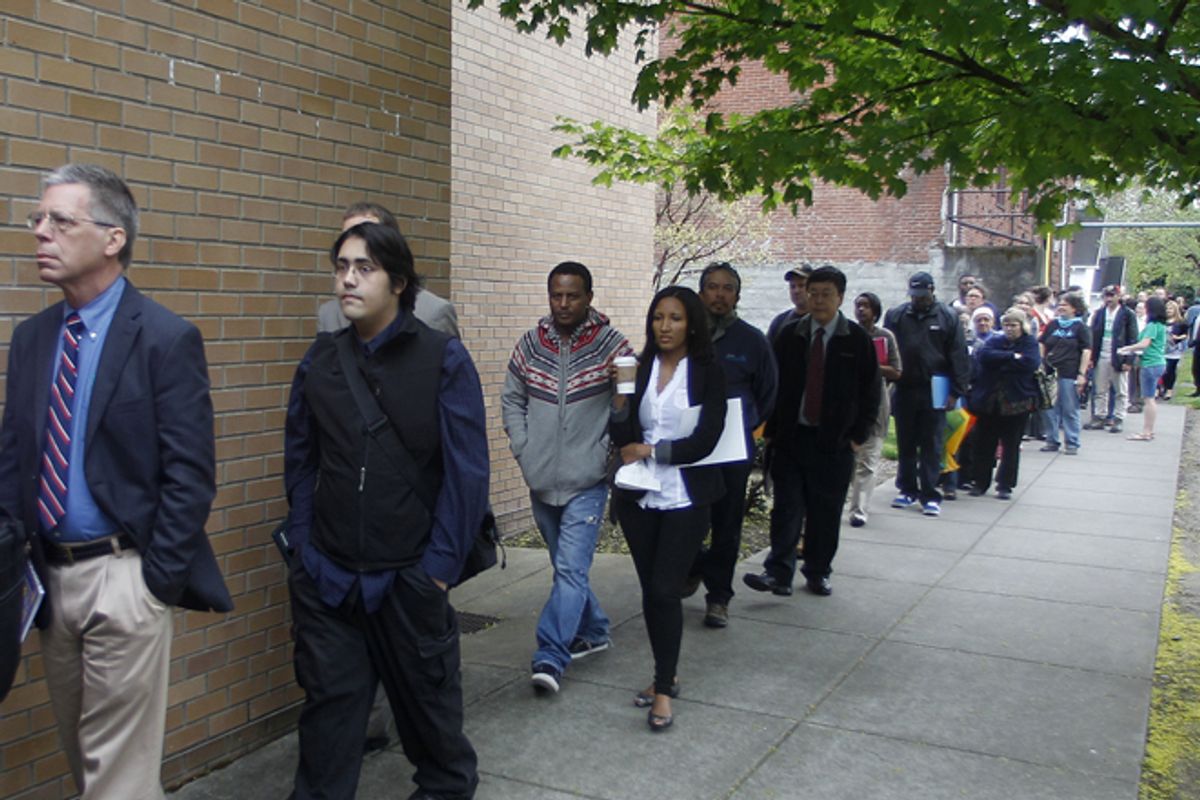WASHINGTON (AP) — U.S. employers added 162,000 jobs in July, a modest increase and the fewest since March. Still, the unemployment rate fell to a 4½-year low of 7.4 percent, a hopeful sign.
Unemployment declined from 7.6 percent in June because more Americans found jobs, and others stopped looking and were no longer counted as unemployed.
Still, Friday's report from the Commerce Department pointed to a less-than-robust job market. It suggested that the economy's subpar growth and modest consumer spending are making many businesses cautious about hiring.
The government said employers added a combined 26,000 fewer jobs in May and June than it previously estimated. Americans worked fewer hours in July, and their average pay dipped. And many of the jobs employers added last month were for lower-paying work at stores, bars and restaurants.
For the year, job growth has remained steady. The economy has added an average 200,000 jobs a month since January, though the pace has slowed in the past three months to 175,000.
Friday's jobs report "reveals a mixed labor market picture of continued improvement, but at a still frustratingly slow pace," said Scott Anderson, chief economist at Bank of the West.
The reaction from investors was slightly downbeat. The Dow Jones industrial average dropped 22 points in early-afternoon trading, and broader stock indexes also declined. The yield on the 10-year Treasury note fell to 2.62 percent from 2.71 percent.
The Federal Reserve will review the July employment data in deciding whether to slow its $85 billion a month in bond purchases in September, as many economists have predicted it will do. Weaker hiring could make the Fed hold off on any pullback in its bond buying, which has helped keep long-term borrowing costs down.
Yet it's possible that the lower unemployment rate, along with the hiring gains over the past year, could convince the Fed that the job market is strengthening consistently.
"While July itself was a bit disappointing, the Fed will be looking at the cumulative improvement," said Paul Ashworth, chief U.S. economist at Capital Economics. "On that score, the unemployment rate has fallen from 8.1 percent last August to 7.4 percent this July, which is a significant improvement."
But Beth Ann Bovino, senior economist at Standard & Poor's, said she thinks Friday's report will make the Fed delay any slowdown in its bond purchases.
"September seems very unlikely now," she says. "I'm wondering if December is still in the cards."
The decline in unemployment to 7.4 percent was derived from a survey of households, which found that 227,000 more people said they were employed last month. And 37,000 people stopped looking for work and were no longer counted as unemployed.
The job gain for the month was calculated from a separate survey of employers.
Though much of July's job growth was in lower-paying industries, manufacturing, a generally good-paying sector, added 6,000 jobs. That increase was driven by job growth at auto plants. Those were the first such gains at U.S. factories since February.
Jobs in professional services, such as finance, accounting and information technology, also rose.
Governments added jobs for the first time since April. All of it was driven by a fifth straight month of hiring by local governments.
Still, many of the jobs that employers added in July are only part time. The number of Americans who said they were working part time but would prefer full-time work stands at 8.2 million — the highest since last fall.
And the percentage of Americans either working or actively looking for work dipped in July to 63.4 percent. This is called the "labor force participation rate." The participation rate has been generally declining since peaking at 67.3 percent in 2000. That's partly the result of baby boomers retiring and leaving the workforce.
Job gains are being slowed by the economy's tepid growth. It grew at an annual rate of just 1.7 percent in the April-June quarter, the government said this week. That was an improvement over the previous two quarters, but it's still far too weak to rapidly lower unemployment.
Recent data suggest that the economy could strengthen in the second half of the year. A survey Thursday showed, for example, that factories increased production and received a surge of orders in July, propelling the fastest expansion in more than two years.
The survey, by the Institute for Supply Management, also showed that the housing recovery is spurring more output by lumber companies, furniture makers and appliance manufacturers.
Businesses have ordered more industrial machinery and other equipment for four straight months. Europe's troubled economies are showing signs of recovery, potentially a lift to U.S. exports.
U.S. automakers are reporting their best sales since the recession, a sign that Americans are confident enough in their finances to make large purchases. Car sales rose 14 percent in July from 12 months earlier to 1.3 million.
Healthy sales have encouraged more hiring by Ford Motor Co. The company said last week that it will hire 800 salaried professionals this year, mostly in areas like information technology, product development and quality control.



Shares